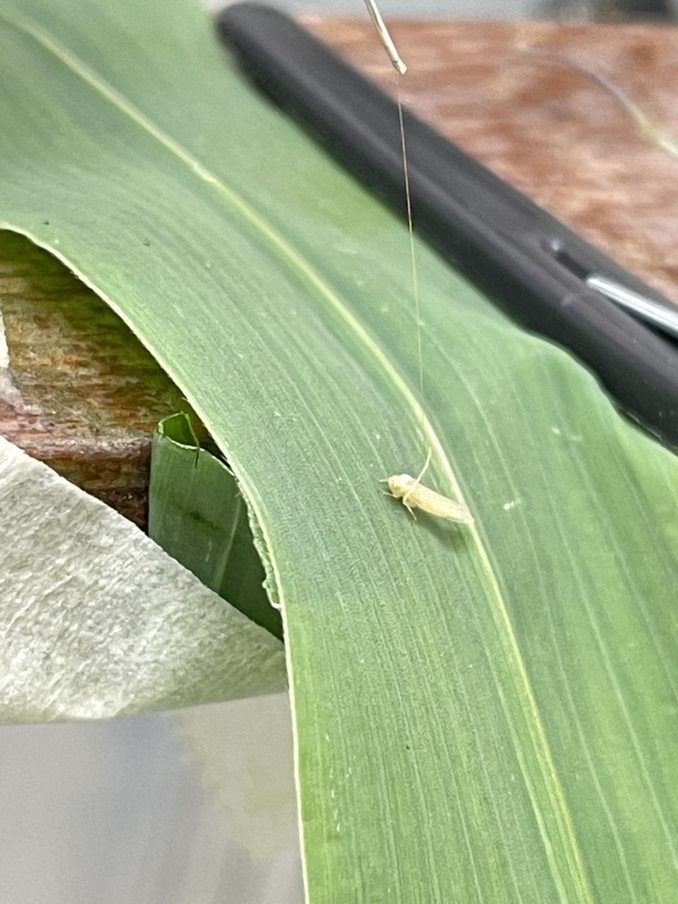

The EPG system at work in the laboratory: electrodes are connected to insects on corn plants (photo: Nathalie Maluta)
Described in the journal Scientific Reports, the research was conducted at SPARCBio, a center established by FAPESP and biological control company Koppert at the University of São Paulo’s Luiz de Queiroz College of Agriculture.
Described in the journal Scientific Reports, the research was conducted at SPARCBio, a center established by FAPESP and biological control company Koppert at the University of São Paulo’s Luiz de Queiroz College of Agriculture.

The EPG system at work in the laboratory: electrodes are connected to insects on corn plants (photo: Nathalie Maluta)
By José Tadeu Arantes | Agência FAPESP – The Corn leafhopper Dalbulus maidis has become a serious problem for farmers. This tiny insect is now widely distributed in the Americas, from the south of the United States to the north of Argentina. In Brazil, it uses only corn plants as hosts, and little is known about its survival mechanisms in the absence of these plants. In corn, it causes damage directly by sucking sap from the phloem, the vascular tissue that conducts sugar and other metabolic products downward from the leaves.
This is not the only problem, however. The insect also transmits pathogens (bacteria and viruses) that stunt plant growth and potentially ruin an entire crop. It is usually combated by spraying the crop with pesticides or biological control agents to reduce the population of these insects and prevent the transmission of pathogens to new plant hosts. Chemical insecticides are the main weapons, but they have adverse side effects, and biological control is a growing alternative.
Some commercially available bioinsecticides currently contain Cordyceps javanica (formerly called Isaria fumosorosea or Cordyceps fumosorosea), a generalist fungus with high potential for controlling sap-sucking insects. Exactly how it does so was poorly understood until a study was conducted to elucidate the action of this entomopathogenic fungus on D. maidis at the São Paulo Advanced Research Center for Biological Control (SPARCBio), established by FAPESP and Koppert Biological Systems at the University of São Paulo’s Luiz de Queiroz College of Agriculture (ESALQ-USP).
The investigation was conducted by agronomist Nathalie Maluta, a researcher at SPARCBio and Koppert Brazil. She is the first author of an article on the study published in the journal Scientific Reports. The co-authors are Thiago Rodrigues de Castro, head of research and development at Koppert Brazil; and João Roberto Spotti Lopes, a professor at ESALQ-USP.
“Our study showed that the fungus begins affecting the insect’s behavior two days after the crop is sprayed with bioinsecticide, reducing its activity in terms of both feeding on phloem sap and transmitting plant pathogens,” Maluta told Agência FAPESP.
Electrical penetration graphing (EPG), the technique she deployed, is relatively unknown in Brazil and can be considered analogous to measuring the electrical activity of the heart by electrocardiogram. A test specimen of D. maidis was connected to an electrode, and the activity of its stylet, a hollow feeding organ resembling a drinking straw, was plotted as a graph as it probed the plant’s tissue to suck the sap.
“EPG generates waveforms for voltage level, frequency and amplitude, which can be correlated with the insect’s biological activities, enabling the researcher to observe in real time what it’s doing or what’s happening to it, including the effects of the bioinsecticide on its sucking or pathogen transmission activity,” Maluta said.

D. maidis is connected to an EPG electrode as it sits on a corn leaf (photo: Nathalie Maluta)
“The product with the fungus is sprayed onto the plant so as to cover all the insects there and form a film on the surface of the plant. Insects that arrive later will come into contact with this film, and the fungus will penetrate their bodies one way or another. Its effect isn’t immediate. It needs a few days to germinate and produce spores, leading to the death of the insects. Well before that, however, the fungus begins affecting their behavior, including how they feed.”
The action of C. javanica is entirely specific and does not constitute a hazard for human or animal consumption – so much so that its use is permitted on organic crops. “This fungus is natural and exists in the wild. It wasn’t made in the laboratory by genetic manipulation,” she said.
D. maidis has been spreading very rapidly, Maluta explained, owing to climate change, large-scale expansion of monoculture, and above all improper use of management tools such as chemical control. “Application of chemical insecticides without prior monitoring, and without knowing whether control measures are required, leads to selection of resistant individuals. Susceptible individuals die and resistant ones continue to feed on the crop. Eventually, no control instruments work any longer. Management strategies need to change radically,” she said.
“D. maidis has affected corn for a long time, but in recent years the population has exploded. One of the reasons is shorter crop cycles, including the introduction of a winter crop [safrinha], which boosts proliferation of these insects because they have food practically all year round.”
The article “DC-electrical penetration graph waveforms for Dalbulus maidis (Hemiptera: Cicadellidae) and the effects of entomopathogenic fungi on its probing behavior” is at: www.nature.com/articles/s41598-023-48779-x.
Republish
The Agency FAPESP licenses news via Creative Commons (CC-BY-NC-ND) so that they can be republished free of charge and in a simple way by other digital or printed vehicles. Agência FAPESP must be credited as the source of the content being republished and the name of the reporter (if any) must be attributed. Using the HMTL button below allows compliance with these rules, detailed in Digital Republishing Policy FAPESP.





